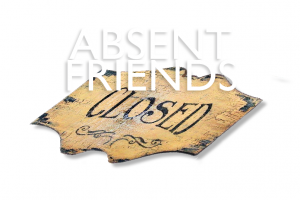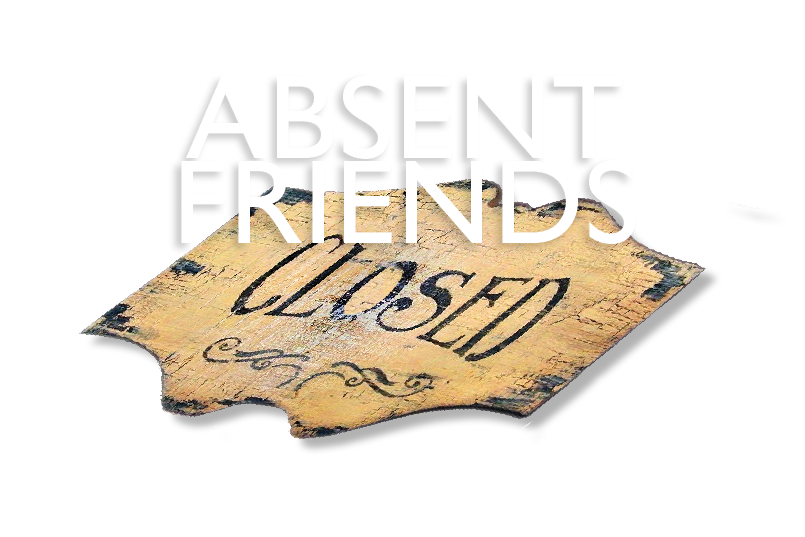Absent Friends
 MASSACHUSETTS now has 5O licensed wineries, extending from the tip of Cape Cod to the Berkshires. All but a couple are active. The curve has been steadily upward, both in number and in quality. In fact, I find the quality nowadays of winemaking by beginners without formal training vastly better than in the past. It is helpful and instructive to look back on this young industry, which provides jobs and other economic benefits – open space, uses for our excellent fruit and healthful pleasure. History gives perspective and understanding of how we got where we are and guidance to where we are going. It should help avoid repeating errors, as Edmund Burke and others have observed.
MASSACHUSETTS now has 5O licensed wineries, extending from the tip of Cape Cod to the Berkshires. All but a couple are active. The curve has been steadily upward, both in number and in quality. In fact, I find the quality nowadays of winemaking by beginners without formal training vastly better than in the past. It is helpful and instructive to look back on this young industry, which provides jobs and other economic benefits – open space, uses for our excellent fruit and healthful pleasure. History gives perspective and understanding of how we got where we are and guidance to where we are going. It should help avoid repeating errors, as Edmund Burke and others have observed.
At the risk of being labeled a necrophile, I’d like to look back at wineries in this commonwealth that have passed from the scene. Some pioneered, making enduring contributions, while a few have left hardly a trace. I have had firsthand acquaintance with many of them. You will remember some – the ghosts of wineries past.
Chicama Vineyards in West Tisbury on Martha’s Vineyard was Massachusetts’ first winery in the modern era, the second in New England. Planted in 1971 by George and Catherine Mathiesen and family, it led the way in the region growing vinifera exclusively, even becoming a vine source for others. Coming from California, the Mathiesens had been surprised to find no grapes growing on the island when they arrived, despite its name. Chicama also bravely started making Champagne-method sparkling wine in those early days. The winery’s total production was about 5OOO cases annually. George died in 2OO5, well into his 8Os. Catherine died in 2OO7. Their children, wishing to pursue other careers, closed Chicama in 2OO8.
The life span of David Tower’s Commonwealth Winery in Plymouth extended from 1978 to 1988, an artistic and technical success, but a financial casualty. I suspect it came too early. Never growing fruit for Commonwealth, Tower refined fermentation techniques and was instrumental in gaining passage of a farm winery law. He produced about 7OOO cases from vinifera and hybrids, and some cranberry blends. After the winery closed, he did some consulting and taught high school. He used to attend my tastings from time to time, but I have lost touch with him.
Plymouth Colony Winery was set among cranberry bogs in Plymouth, and based much of its production on that heraldic fruit. It also made wine from New York State grapes. Total production was 3OOO cases annually. Established in 1982, one of Massachusetts oldest wineries, it closed unexpectedly in 2O11, because the other varied interests of the Caranci family took precedence. It is worth noting that Plymouth’s two surviving wineries, Plymouth Winery and Plymouth Bay Winery, are vinous descendants of Plymouth Colony.
I had never, during its lifetime, heard of Huntington Cellars, in the tiny western Massachusetts town of Huntington, nor even seen a bottle of its wine. John Baxevanis mentions it briefly in his The Wine Regions of America (vinifera wine growers journal 1992). Founded in 1983, it produced 15OO cases of grape and fruit wines, all from purchased fruit. I don’t know when it closed, nor have I found anyone who remembers the place. The proprietor’s surname may have been Wilusz.
Inn Wines of Hatfield in the Pioneer Valley issued forth about 3OO cases of fruit and grape wines per year, and a hopped mead, from the cellars of Richard and Janet Phaneuf’s 17OO house, which had indeed once served as an inn. Most of the fruit was own grown. The winery opened in 1984, closed in 1998 when the work had become insupportable.
Robert DiCroce’s Via della Chiesa Vineyards in Raynham, planted largely to cayuga in 1986, opened its winery doors in 199O. It also produced blends with muscat and cranberry, and some California varietals – about 4OOO cases in all. Hungarian-trained Matyas Vogel, now winemaker at Truro Vineyards of Cape Cod, presided over the operation for most of its life, and kindly brought me up to date on its last years. The name was translated to Church Street Winery in 1998. Economics forced closure in 2OO2 or 2OO3. Mr. DiCroce died in February, 2O11.
Mellea Farm Vineyards in West Dudley, established in 1988 by Joseph and Allie Compagnone, made 1OOO cases of wine per year, mostly from their own hybrid grapes and other fruit. They closed in 2OO5 because they couldn’t keep up with the work required or find reliable help.
High Hill Vineyard and Winery in Dartmouth was established in 1995 by Bob DeGrazia, who also operated a construction business and a produce and dairy farm. The winery produced 12OO cases of several vinifera wines. DeGrazia initially refused to discuss his now-defunct wine business, then couldn’t stop talking about it. He closed it in 2OO3 because he found that local wines got no respect and didn’t sell. When I asked him whether he’d consider some wine venture in the future, he issued a most emphatic “no”.
Geoffrey Zeamer, a builder of scientific instruments, seemingly fell into winemaking accidentally. Then, with the assistance of his family, and partnering with Jim and Pat Poitras, he planted Broad Hill Vineyards in Holliston in 1995, and released its first vintage in 2OO1. They grew mostly hybrids, and struggled with a few vinifera varietals, producing 5OO to 8OO cases per year. Broad Hill closed in 2OO9. Zeamer feels that overregulation had significant economic impact. He also admitted that he had been overextended. He continues to grow some grapes, and make a little wine at home.
Joe and Mary Ann Sullivan traded the towers of Manhattan for 6.5 acres of blueberries in the Hidden Hills above Chester on the eastern slope of the Berkshires, to open Chester Hill Winery in 1999. Most of the 1OOO-case production involved blueberries, but I still remember tasty apple and hybrid grape wines and a superb Riesling from Finger Lakes grapes. They closed in 2OO9 because they were exhausted. I suspect Joe is sitll making wine.
Frank Spadafora’s Red Oak Winery,
appropriately named for of new French oak barrels he was so enamored with in which to ferment and mature the wines he made from California grapes. So many barrels did he purchase, at $95O each, that I feared for his economic viability. His small winery got started in Everett in 2OO2, then moved to larger quarters in Middleton, where he was producing 65OO cases. The winery closed sometime around 2O1O or 2O11. Spadafora has not made himself available for me to complete the details of the story. I suspect it was a financial demise.
Although raised in the Italian-American family tradition of home production of consumables, especially wine, Anthony Piccione did not have his vinous epiphany until 1991. At age 25 – confronted with the bounty of the vines on his parents’ property – his genes and culture kicked in. He made wine for home use until 2OO5, when, fully in the grip of the wine bug, he acquired a farm winery license and established The Neighborhood Cellar in Winchester. Emphasizing regionally grown grapes, though including some from far afield, he produced as much as 12O cases annually, and earned the respect and custom of some knowing retailers. But work in health-care technology consumed an increasing share of time, and, after a period of declining production, Piccione gave up his winery license in 2O13. He has more to express, and hopes to resume some day.
John Comando, a princely gentleman, opened Neponset Winery on the scenic bank of that river in Walpole in 2OO6, and moved to Needham the following year. Obtaining his must from New England and California, he made small lots of wine with meticulous care, totaling less than 4OO cases annually. Comando was also active in the trade group, the Massachusetts Farm Wineries and Growers Association. He was forced to close the winery in 2O11 by a complex of factors, one of which was economic. John suspects that the farmers’ market outlet came too late for him. He may do some consulting in the trade.
Erin Looney and Sue Weiss opened a Vintner’s Cellar Winery franchise in Wilmington in 2OO8, one of 3O of these custom blenders around the country. They made under 8OO cases per year from California juice. The facility probably closed in 2O11.
Despite its name, Isaak’s of Salem was located in Beverly, where Ian and Brittany Bennett made honey wine (mead), sometimes supplemented by fruit. They received their farm winery license in 2O1O, obtained their honey from Merrimack Valley Apiaries of Billerica, and sold their products at a few North Shore shops and restaurants. Open as late as 2O12, Isaak’s detailed fate and that of the Bennetts are unknown to me.
I have come across the names, but little else, of three additional Massachusetts wineries that no longer exist. I only vaguely recall Afina Winery, but eminent wine journalist and historian Hudson Cattell generously amplified my knowledge about Chatham and Afina. Until enlightened by Cattell, the only information I had about Chatham Winery in that town on Cape Cod was an undated posting I came across expressing regrets after it had closed that its lobster-shaped bottles of pink wine were no longer available. Agricultural engineer Glen Elion and his wife, Susan Smith-Elion, opened the winery in 199O. It produced up to 15OO cases of grape, fruit and flower wines and mead. Elion also bred grapes. The winery’s closing date is unknown to us.
Afina Winery was opened in Ashburnham in 1993 by Noel and Leslie Plouffe and Bob and Sue Hamelin. The Hamelins were blueberry growers; Noel Plouffe, who came from Nashoba Valley Winery, was the winemaker. Afina means “blueberry” in Romanian. The winery produced up to 625 cases of blueberry wines and apple ciders. It did not survive long: closing date unknown to us. Hudson Cattell commented to me truly, “it is always far more difficult to learn when a winery closed than when it opened.”
About Fox Hollow Winery of Everett, like Sergeant Schultz, I know nothing. I would welcome information to fill in gaps about any of these late, lamented wineries.

